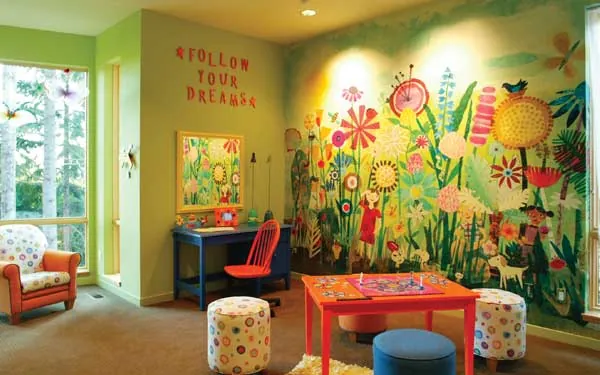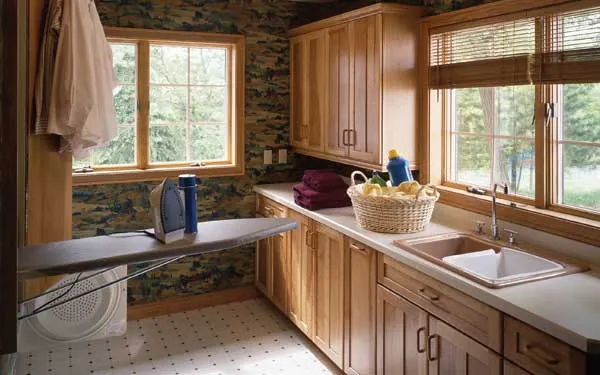 by Jennifer Jones
by Jennifer Jones
When designing your dream home, many people search out floor plans that have the spaces to fit their needs. Home plans usually label each room in the house with a name and its dimensions. Many of these include, but are definitely not limited to, dining room, living room, family room, great room, kitchen, bedrooms, bathrooms, media room, and the listings keep going. However, does your family really need a living, family AND great room? There are a number of ways to describe the living spaces of a home. Most people understand that the listed “family” room could be more useful as a craft or music room. If you need a space for toys, consider turning that hearth room into a playroom for the kids. Even though the room is labeled as one thing, the homeowner can easily convert it into a functional space that fits their living requirements.

View This House Plan
There are a lot of things to consider when planning out your perfect home. If you are feeling lost and confused, try beginning with your existing home. Many people will create a list of every room in their home as well as its function and how often it is used for that purpose. You might be surprised that you have several rooms that you never use, like that spare guest room that’s gathering dust or the formal dining room where no one eats. In the meanwhile, the craft supplies are piling up in the corner of your bedroom and the dirty laundry keeps cramping the bathroom. Now that you have a better idea of the needs of your family, it will be easier to separate the essential rooms from the flexible ones.
ESSENTIAL ROOMS
Whether you are looking for a cozy cottage or sprawling luxury home, there are basic areas that make up a home. A place to eat and prepare meals is always a necessity. Designated sleeping spaces are important as well as a place to toilet and shower. Most other rooms can be changed according to your lifestyle, but here are usually the bare minimum requirements for a home plan.

View This House Plan
Kitchen: The kitchen is a multi-purpose room that often becomes the main gathering spot of the home. Family members use it as a drop zone for keys and bags. Guests will gather to snack on appetizers, enjoy drinks and chat with the host while preparing meals. It is the control center for household chores and other responsibilities that need to get done for the week. Kitchen designs can range anywhere from one simple wall to a U-shaped design with two islands. Many kitchens feature some sort of dining option as well, whether it is an eating bar or enough floor space for a dining table.
Living room: Even the smallest of cottages usually include a living space, although it may be shared with the kitchen or a sleeping area. In most homes, this space is the largest room of the house and time is spent there relaxing or lounging with guests. More lavish living rooms will include features such as a media center, fireplace and built-in bookshelves.
Bedrooms: Every person needs sleep and a place to rest. For just a cabin in the woods, some plans offer a modest sleeping area, however, even most simple floor plans will include at least one bedroom for privacy. When it comes to planning your dream home, the size of your family will help determine how many bedrooms will suit you. Even for a small family, it is always a good idea to plan for more and you can always use that extra bedroom as another functional space. Whether it is a pullout futon in the sleeping area next to the kitchen, or a deluxe master suite with a bay window and private master bathroom, bedrooms are a major requirement when designing your home plan.
Bathroom: Indoor plumbing has been one of the 20th century’s most amazing accomplishments. Every home in America features at least one full bath with space for a shower, sink and toilet. Many homes include more than one bath, some with other full baths, while some with a half bath with a toilet and sink. Dream homes come complete with several bathrooms. Sometimes each bedroom will have its own private bathroom. Master bathrooms can be incredibly luxurious, featuring dressing areas, double vanities, walk-in closets, whirlpool tubs and much more.
FLEXIBLE ROOMS
Now that you have made a list of the fundamental rooms, you can start considering the other adaptable spaces that fit your needs. Many home plans will include multiple living spaces. Some even call out a room as a “flex space,” leaving the option open to the homeowners choosing. This is to remind the buyer that their dream home can have any room that they desire. Many people discover that redesigning these spaces can provide a more purposeful room.
Foyer: This is the first room that you step into when you enter the home, so it is important to make a good impression. It is common for smaller homes to open directly into the living room, but an entry area can easily achieved by the arrangement of furniture. Many foyers will include a seat as well as a closet for ease when removing shoes and coats. Some homes enjoy the luxury of a mudroom near the front entrance or the garage entrance. If you do not have a designated mudroom and would like one, it is easy to convert a family room at the front of the home into this space. For a mudroom near the garage entrance, some people will make use of a breakfast area and add a bench with storage space.
Dining room: Just about any space can be converted into a dining room. Additionally, just about any dining room can be changed into a more functional space. Most families will enjoy meals around a table in the breakfast area or at the eating bar in the kitchen. If you entertain guests often, a formal dining room would be a good choice for you. However, some people only use their dining room a few times a year. If this is the case, you may want to change that dusty room into an office or even a playroom. Chances are that that dining room table already has papers and other projects lined up on it anyway.
Family room: Family rooms are often located near the kitchen and they are the perfect place for comfortable lounging and an entertainment center. It is where the homeowners go to unwind, relax and enjoy some television before bedtime. A family room differs from a living or great room in the aspect that it is much less formal. This space is very flexible and can include a project table, space for toys or other items that best suit your needs.
Study/Library/Office/Studio: A study or office is especially useful for homeowners who work from home. A dining room, family room or spare bedroom can easily be converted into a functional workspace. Keep in mind, however, that you will want to be able to have a certain amount of privacy for an office or studio space. French doors provide an elegant solution to privacy concerns. A library, on the other hand, can be easily paired with the living or great room. Guests will love the beauty of built-in bookshelves filled will all kinds of reading material as well as displays of collections and photographs.
Reading/computer nook: Nooks and niches are perfect for the kids in the house. It is a public, yet cozy spot where they can do their homework or play on the computer. A breakfast area or even a stair landing can be utilized as a computer nook. These locations are perfect for parents who want to be able to monitor Internet activity, while allowing the children a certain amount of privacy from the busier areas of the home.

View This House Plan
Theater/Media/Game room: A ping pong or pool table requires a fairly large and comfortable area. Game rooms are often accompanied by a wet bar or cellar, and include televisions as well as other forms of entertainment. Generally homeowners will create a media room in the basement, since the openness is useful for larger furniture. Lower levels are also excellent for theater rooms, since the lack of windows provides the perfect movie experience. Second floor bonus rooms also make excellent media rooms.

View This House Plan to the left
Music room: The beautiful music of a grand piano is a luxury that many homeowners want to enjoy. It provides a classic elegance to any living or great room. A smaller piano is the perfect fit for a family room. No matter what space that you choose for a piano, be sure to avoid an area that receives a lot of direct sunlight that may damage the musical equipment.

View This House Plan
Kids Playroom: Bonus rooms are great for playrooms, however, some parents prefer to have the play space closer to the living areas of the home. This will help when monitoring the children. Just about any room can be converted into a kid’s room. The keys to having a good playroom are storage and safety. Cabinets, closets, shelves and bins are a necessity for all the games, figures and knickknacks that kids’ collect over the years. Safety is also a major concern for creating a comfortable playroom. Electrical outlets, falling objects, nearby bathrooms and even windows should be kept in check to provide a secure and harmless environment for the little ones.
Exercise room: Many people do not like the hassle of going to the gym to get a good workout. A spare bedroom or sunroom can be changed into the perfect exercise room. Most people enjoy a space that has windows for a refreshing view. For larger equipment, a basement area can provide ample space for a comfortable exercising.

View This House Plan
Storage/Laundry room: Ranging in sizes, a laundry room can also double as a storage space. Smaller homes may include just a laundry closet with a stackable washer and dryer, while other homes enjoy the amenity of an entire room with counter and closet space. If your laundry room does not have enough space, you can always turn that spare bedroom into a storage area. Basements and attic spaces also provide an excellent storage option that is separate from the popular living areas of the home.
Home plans come in an enormous variety of sizes and styles. Designers label the rooms to help the customer get an idea of what that space can be used for the best. However, many architects are including spaces that are purely flexible to be utilized to the needs of the homeowners. From hearth and gathering rooms to dens and recreation rooms, the title of the room is not as important as the function of the space. Once you have an idea of the spaces that you desire, you are ready to begin comparing floor plans from houseplansandmore.com to get the design that is perfect for you!
Here are some related articles:
Save this article to:
back to top